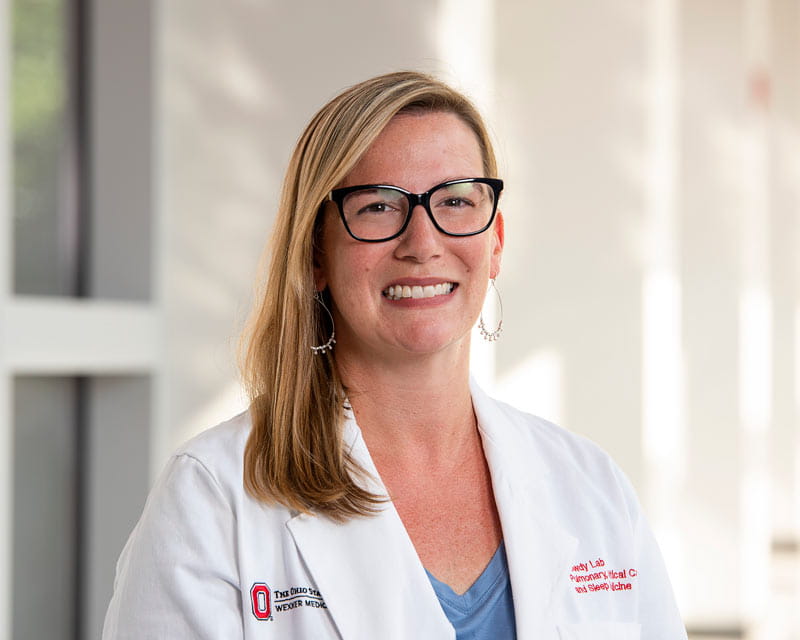
Ohio State Researchers Launch NIH-Funded Study on Ozone-Induced Pulmonary Inflammation
 Every year, 2 to 3 million critically ill patients rely on mechanical ventilation to sustain their lives, and the need for therapeutic oxygen delivery becomes more crucial during global crises like the COVID-19 pandemic. However, striking the right balance in oxygenation is a complex process, and both hypoxia and hyperoxia can have devastating health consequences, ranging from cardiovascular collapse, respiratory arrest and long-term cognitive decline on one extreme, to acute lung injury, ventilator-associated pneumonias and worse hospital outcomes at the other.
Every year, 2 to 3 million critically ill patients rely on mechanical ventilation to sustain their lives, and the need for therapeutic oxygen delivery becomes more crucial during global crises like the COVID-19 pandemic. However, striking the right balance in oxygenation is a complex process, and both hypoxia and hyperoxia can have devastating health consequences, ranging from cardiovascular collapse, respiratory arrest and long-term cognitive decline on one extreme, to acute lung injury, ventilator-associated pneumonias and worse hospital outcomes at the other.
“Oxygen is a lifeline in critical care, but maintaining the right levels remains a challenge,” says Sonal Pannu, MBBS, a pulmonologist and critical care physician at The Ohio State University Wexner Medical Center and clinical associate professor of Internal Medicine for the Division of Pulmonology, Critical Care and Sleep Medicine in The Ohio State University College of Medicine. “This study comes at a pivotal moment, allowing us to address the critical oxygenation ascertainment gaps that persist in health care in relation to racial differences.”
As Dr. Pannu explains, the widespread prevalence and indispensable role of SpO2 in guiding oxygen therapy during the COVID-19 pandemic underscored its significance as a diagnostic tool for the population.
“Multiple studies have brought attention to the biases and occult hypoxemia that persist due to racial disparities in skin tone when SpO2 is employed as an oxygenation target,” she says. “These studies have also illuminated the fact that occult hypoxemia results in delayed treatment and worse hospital outcomes. Addressing this critical issue becomes imperative in improving patient outcomes.”
Dr. Pannu and her team propose an innovative adaptive strategy. By comparing actual arterial oxygen saturation and pulse oximetry for each patient, their aim is to develop a personalized oxygenation protocol that bypasses the limitations of skin tone and ensures accurate care delivery.
“This approach not only challenges existing norms, but also paves the way for a transformative shift in critical care practices,” she says.
Clinical guidelines and recent data suggest providers use fraction of inspired oxygen supplementation to the lowest level necessary to maintain physiologically safe oxygenation. As a result, the central goal of this study is to mitigate the hidden dangers of occult hypoxemia, a condition where oxygen levels appear stable while being dangerously low due to skin tone. Yet the research team seeks to simultaneously prevent hyperoxia by tailoring oxygen delivery to each patient’s unique requirements. This approach ensures that patients receive the optimal amount of oxygen without the risks of overexposure.
“A uniform methodology for managing occult hypoxemia in all patients can result in the unintended issue of hyperoxemia,” Dr. Pannu says. “In many ways, it’s simply easier to call for more oxygen than it is to reduce oxygen. Yet when health care providers are not able to balance the risks of these opposites — too much or too little oxygen — the consequences can be severe.”
In this study, after the care team screens for occult hypoxemia or hyperoxia, they’ll adjust the oxygenation goals accordingly and introduce an implementation scheme for those defined targets.
“This will provide a precise oxygenation strategy for each patient, irrespective of skin tone,” she says. “This is the first and only oxygenation study so far to utilize this correlative strategy.”
Dr. Pannu’s research grant will also allow her team to explore potential biomarkers related to overuse of oxygen.
“If we can identify accurate biomarkers for hyperoxic lung injury, this could strengthen best practices for optimal oxygen titration, which ultimately improves patient outcomes,” she says. “We believe using oxidized lipids biomarkers can lead to breakthrough clinical and translational approaches for safe mechanical ventilation for all populations.”
This new Ohio State study follows a pilot study of 135 participants that used real-time electronic health records to show that a conservative oxygen titration strategy safely reduced hyperoxemia by a median of 7.5 hours, suggesting a shorter duration of mechanical ventilation.
This second research phase is a cluster-randomized, unblinded, stepped wedge clinical trial that will follow more than 1,000 patients needing mechanical ventilation in medical, surgical and cardiac intensive care units across the Ohio State Wexner Medical Center. Using an analysis of oxidized lipid biomarkers that indicate hyperoxia-associated lung injury, the study will compare the outcomes of patients who were treated using an optimized targeted oxygenation strategy versus usual care. The goal isn’t only to validate the efficacy of the targeted oxygenation strategy, but also to explore novel biomarkers indicating hyperoxic lung injury.
Dr. Pannu emphasizes the broader impact of this research.
“Beyond immediate patient benefits, this study establishes the foundation for future research advancements,” she says. “It sets the stage for refining trial methodologies, improving recruitment strategies and enhancing the higher fidelity data analysis for upcoming studies. The potential for transformative breakthroughs in critical care research is immense.
“We’re not only delving into precision oxygenation, but also taking a significant strive forward in addressing health care disparities. By bridging these gaps in knowledge and pioneering truly personalized care, we hope to redefine critical practices, ultimately improving patient outcomes and setting a new standard for medical research excellence.”
Learn more about innovations in care and research from the Division of Pulmonary, Critical Care and Sleep Medicine.